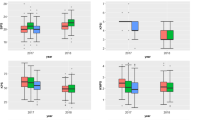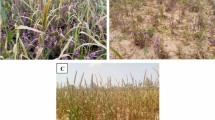Abstract
Key message
We apply the GWAS to sweet potato genome, and identified the SNPs associated with yield and weevil resistance.
Abstract
The sweet potato (Ipomoea batatas (L.) Lam) is a highly heterozygous, outcrossing, polyploid species, which presents challenges for genetic analysis. Therefore, we considered that genome-wide association studies (GWAS) may be applied to the study of the sweet potato genome. The yield of two sweet potato varieties [Purple Sweet Lord (PSL) and 90IDN-47] was assessed at two locations (Kumamoto and Okinawa prefectures) in Japan in 2013 and the yield scores were used for GWAS. The results showed that there were several single nucleotide polymorphisms (SNP) above the significance thresholds in PSL; two peaks were detected in Kumamoto and Okinawa on the Ib03-3 and Ib01-4 linkage groups of PSL, respectively. As for 90IDN-47, one relatively high peak was detected in Kumamoto on the Ib13-8 linkage group. Interestingly, although high peaks above significance thresholds were detected in Kumamoto and Okinawa in PSL, the peaks were located in different linkage groups. This result suggests that the genetic regions controlling yield may change in response to environmental conditions. Additionally, we investigated the degree of weevil damage to the plants, which is the greatest problem in sweet potato cultivation in Okinawa. In this experiment, no SNPs were identified above the significance thresholds. However, one relatively high peak was found in the 90IDN-47 genotype, which showed resistance to weevils. On the other hand, one relatively high peak was also detected in the PSL genotype, which showed susceptibility to weevils. These results suggest that two regions could affect weevil resistance and may contain the gene(s) controlling weevil resistance.






Similar content being viewed by others
References
Ames T, Smit NEJM, Braun AR, O’Sullivan JN, Skoglun LG (1997) Sweet potato: major pests, diseases, and nutritional disorder. International Potato Centre, Lima, p 155
Brachi B, Morris GP, Borevitz JO (2011) Genome-wide association studies in plant: the missing heritability is in the field. Genome Biol 12:232
Cervantes-Flores JC, Yencho GC, Kriegner A et al (2008) Development of a genetic linkage map and identification of homologous linkage groups in sweet potato using multiple-dose AFLP markers. Mol Breed 21:511–532
Chang KY, Lo HF, Lai YC et al (2009) Identification of quantitative trait loci associated with yield-related traits in sweet potato (Ipomoea batatas). Bot Stud 50:43–55
Endelman JB (2011) Ridge regression and other kernels for genomic selection with R package rrBLUP. Plant Genome 4:250–255
Hirakawa H, Okada Y, Tabuchi H et al (2015) Survey of genome sequences in a wild sweet potato, Ipomoea trifida (H. B. K.) G. Don. DNA Res 22:171–179
Jackson DM, Bohac JR (2006) Improved dry-fleshed sweet potato genotypes resistant to insect pests. J Econ Entomol 99:1877–1883
Jackson DM, Harrison HF Jr, Ryan-Bohac JR (2012) Insect resistance in sweet potato plant introduction accessions. J Econ Entomol 105:651–658
Jansson RK, Raman KV (1991) Sweet potato pest management: a global review: pp 1–12. In: Jansson RK, Raman VR (eds) Sweet potato pest management: a global perspective. Westview Press, Boulder
Khan MA, Korban SS (2012) Association mapping in forest trees and fruits crops. J Exp Bot 63:4045–4060
Korada RR, Naskar S, Palaniswami M, Ray R (2010) Management of sweet potato weevil [Cylas formicarius (Fab.)]: an overview. J Root Crops 36:14–26
Korte A, Farlow A (2013) The advantages and limitations of trait analysis with GWAS: a review. Plant Methods 9:29
Kriegner A, Cervantes JC, Burg K et al (2003) A genetic linkage map of sweet potato [Ipomoea batatas (L.) Lam.] based on AFLP markers. Mol Breed 11:169–185
Li AX, Liu QC, Wang QM et al (2010) Construction of molecular linkage maps using SRAP markers in sweet potato. Acta Agron Sin 36:1286–1295
Margarido GRA, Souza AP, Garcia AAF (2007) OneMap: software for genetic mapping in outcrossing species. Hereditas 144:78–79
Menezes EDLA (2002) A broca da batata-doce (Euscepes postfasciatus): descrição, bionomia e controle. Circular Técnica 6:1–12
Meuwissen THE, Hayes BJ, Goddard ME (2001) Predication of total genetic value using genome-wide dense marker maps. Genetics 157:1819–1829
Monden Y, Tahara M (2017) Genetic linkage analysis using DNA markers in sweet potato. Breed Sci 67:41–51
Monden Y, Hara T, Okada Y et al (2015) Construction of a linkage map based on retrotransposon insertion polymorphisms in sweet potato via high-throughput sequencing. Breed Sci 65:145–153
Nottingham SF, Kays SJ (2002) Sweet potato weevil control. Acta Hortic 583:155–161
O’Hair SK (1991) Growth of sweet potato in relation to attack by sweet potato weevils. In: Jansson RK, Raman KV (eds) Sweet potato pest management: a global perspective. Westview, Boulder, pp 59–78
Okada Y, Yasuda K, Sakai T, Ichinose K (2014) Sweet potato resistance to Euscepes postfasciatus (Coleoptera: curculionidae): larval performance adversely effected by adult’s preference to tuber for food and oviposition. J Econ Entomol 107:1662–1673
Raman KV, Alleyne EH (1991) Biology and management of the West Indian sweet potato weevil, Euscepes postfasciatus. In: Jansson RK, Raman KV (eds) Sweet potato pest management: a global perspective. Westview, Boulder, pp 263–281
Shirasawa K, Tanaka M, Takahata Y et al (2017) A high-density SNP genetic map consisting of a complete set of homologous groups in autohexaploid sweet potato (Ipomoea batatas). Sci Rep 7:44207
Turner SD (2014) qqman: an R package for visualizing GWAS results using Q–Q and Manhattan plots. BiorXiv. https://doi.org/10.1101/005165
Ukoskit K, Thompson PG (1997) Autopolyploidy versus allopolyploidy and low-density randomly amplified polymorphic DNA linkage maps of sweet potato. J Amer Soc Hort Sci 122:822–828
Ward AJ, Bhangoo J, Fernández-fernández F et al (2013) Saturated linkage map construction in Rubus idaeus using genotyping by sequencing and genome-independent imputation. BMC Genom 14:2
Zhao N, Yu X, Jie Q et al (2013) A genetic linkage map based on AFLP and SSR markers and mapping of QTL for dry-matter content in sweet potato. Mol Breed 32:807–820
Acknowledgements
A part of this study was supported by a grant from the Ministry of Agriculture, Forestry, and Fisheries of Japan (Genomics-based Technology for Agricultural Improvement, SFC-3003).
Author information
Authors and Affiliations
Contributions
YO, KS, SI, MT and YM conceived and designed research. YO, KS and YM performed the experiment. KS, KN and YM analyzed the data. YO and YM wrote the manuscript. All authors read and approved the manuscript.
Corresponding author
Ethics declarations
Conflict of interest
The authors declare that they have no conflicts of interest.
Additional information
Communicated by Sang-Soo Kwak.
Publisher's Note
Springer Nature remains neutral with regard to jurisdictional claims in published maps and institutional affiliations.
Electronic supplementary material
Below is the link to the electronic supplementary material.
Rights and permissions
About this article
Cite this article
Okada, Y., Monden, Y., Nokihara, K. et al. Genome-Wide Association Studies (GWAS) for Yield and Weevil Resistance in Sweet potato (Ipomoea batatas (L.) Lam). Plant Cell Rep 38, 1383–1392 (2019). https://doi.org/10.1007/s00299-019-02445-7
Received:
Accepted:
Published:
Issue Date:
DOI: https://doi.org/10.1007/s00299-019-02445-7




